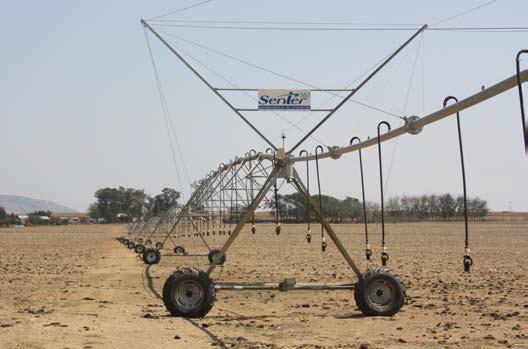Irrigation can drastically improve crop production, but only when the correct management principles are applied.
Drought is any farmer’s worst nightmare. Irrigating your crops will ensure a better harvest, and with advances in different types of irrigation, for example drip irrigation, the practice has become more accessible to farmers. You no longer need to have a river on your farm to be able to irrigate successfully.
Benefits of irrigation
The quantity of natural rainfall that penetrates the soil and becomes available to a plant and the quantity of water needed by that plant for good crop production will seldom be the same. Irrigation is designed to meet the shortfalls in water supply that occur naturally, increasing production or ensuring good production.
For any selected crop, planting date, soil and climate, an analysis can be made of the quantity of water needed to ensure the best possible yield. We know that if less water is applied, plant growth and crop production will be reduced. If a plant has to work hard to get that water that it needs to merely survive, fruit, sugar, starch and leaf production will all suffer. For most types of crop and growing conditions, we would still expect some residual production if we did not irrigate to make up shortfalls in crop water demands.
Dry-land crop production is erratic and will depend largely on highly variable climatic conditions. Crop failures during droughts can cause severe economic hardship. Efficient irrigation can boost crop production and reduce the chance of crop failures.
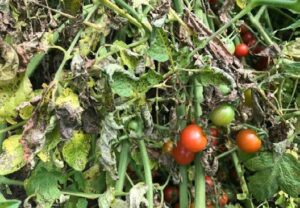
Tomatoes can easily be damaged if water is sprayed directly onto the fruits or leaves. The type of irrigation should meet the needs of the specific crop chosen.
Irrigation does, however, come at a cost. We need to consider the following:
- Even under the best conditions, there is always a risk attached to water supply.
- It costs money to install and operate an irrigation system, and these costs must be recovered by the improvements in crop production.
- The cost of energy (electricity or diesel to motors that drive pumps) can be high.
- Increased crop production can usually only be achieved with higher inputs in terms of management, fertilisers, labour, transport costs and marketing.
The benefit of irrigation can never be measured solely in terms of the value of increased production, but relates to increased profitability after all additional costs are considered.
Consider the following example of maize production in the Natal Midlands of South Africa:
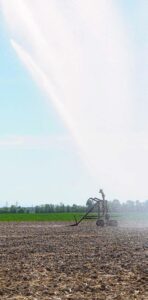
Irrigation
Irrigation will not magically transform an uneconomic dry-land situation into a winning profit situation. Inefficient irrigation, poor soils, or imperfect management can lead to increased losses instead of a benefit. For many different types of crop or soil conditions, there will be no benefit in irrigation unless the best management practices for that farming system are achieved and maintained. Even then, it is not certain that a benefit will be gained in every year. Irrigation benefit is often only seen in terms of long-term average profits.
It is important to distinguish between potential and achievable results.
Suitability of a system for a chosen crop
Many types of irrigation systems may not be suitable for a chosen crop. When individual types of systems are discussed, it is often advisable to indicate the suitability of that system for various crops.
No irrigation system is ideally suited to all crops. A farmer who uses an existing system should be aware of system limitations.
A garden sprayer placed on the ground could, for instance, not be used to irrigate a tall crop such as maize. Water would spray up against the plant leaves and proper distribution of water over a wide area could not be achieved.
This type of emitter would normally only be used to irrigate shorter crops such as cabbages planted in rows.
A crop like tomatoes is sensitive to water droplets that fall on the fruit. Sunlight shining directly onto water droplets can burn spots on the tomato. Ideally, a tomato crop would be irrigated using a flood or dripper system. Any crop will have inherent system design limitations.
Similarly, soils can define the type of system that should be used. The rate at which water infiltrates into the soil could limit application rates, cycle times, or even the selection of a type of irrigation system.
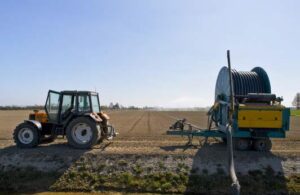
Suitability of a system for a chosen crop
Irrigation practice
Operating, maintaining and managing an irrigation system entail the control of elements that will affect the performance of the system. This section discusses many of the most important elements of irrigation practice.
Pressure
Water can flow from a high to a lower tank by gravity. To transfer water from the low to the higher tank we need to do work. Energy must be spent to lift the water to a higher level. If we raise the end of either hose to the level of water in the tank, water will stop flowing through the pipe. The height to which we need to raise the end of a hose before all flow through the open-end stops can be expressed in terms of a height above ground level at that point. Pressure is measured either in terms of the forces exerted on the pipe wall (kPa), or pressure head (metres).
In essence, water supplied from a tank raised to a height of 10 m above the outlet is delivered at 10 m head, or 100 kPa.
Each type of emitter (water outlet) used in an irrigation system is designed to operate with water supplied at a certain fixed pressure. Water must be supplied at this pressure for the system to work properly.
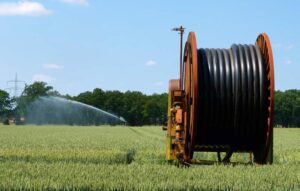
Water can flow from a high to a lower tank by gravity.
Depending on the type of crop, soil conditions and size of the field, these sprinklers can be beneficial over larger irrigation systems such as centre pivots.
Changes in working pressure will change the way that water is distributed. Consider a sprinkler designed to operate at a 30 m head. Higher or lower pressures will alter the pattern of distribution both through the air and as that water sinks into the soil. It is important to know the correct operating pressure for emitters used in the field and to control pressure in an irrigation system.
Gauges in the field should always be clearly marked with the correct operating pressure for the system at that point.
This series is published with acknowledgement to the ARC Agricultural Engineering for the use of their manuals. Visit www.arc.agric.za for more information.

